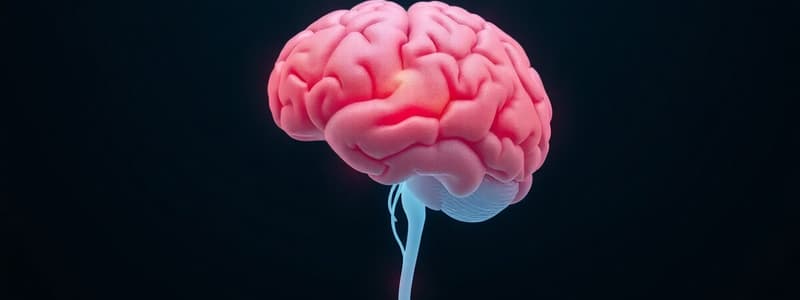Podcast
Questions and Answers
What does the humanistic-existential model emphasize in understanding human behavior?
What does the humanistic-existential model emphasize in understanding human behavior?
- Values and choices (correct)
- Social and cultural influences
- Unconscious conflicts and processes
- Learning methods and behavior
Which aspect is primarily examined by the sociocultural model?
Which aspect is primarily examined by the sociocultural model?
- Individual brain chemistry
- Neural connections within the brain
- Psychotropic medication effects
- Cultural and social forces (correct)
How do biological theorists view abnormal behavior?
How do biological theorists view abnormal behavior?
- As a consequence of learned behavior
- As a result of social influences
- As the outcome of unconscious conflicts
- As an illness caused by physical malfunctioning (correct)
Which of the following treatments is considered part of drug therapy for mental disorders?
Which of the following treatments is considered part of drug therapy for mental disorders?
What is a key focus of the biological perspective in psychology?
What is a key focus of the biological perspective in psychology?
What is the primary function of neurotransmitters in the context of neuron communication?
What is the primary function of neurotransmitters in the context of neuron communication?
Which brain structures are specifically linked to Huntington's disease?
Which brain structures are specifically linked to Huntington's disease?
The sequence of actions that occur when an electrical impulse is transmitted from one neuron to another includes which of the following?
The sequence of actions that occur when an electrical impulse is transmitted from one neuron to another includes which of the following?
Which part of the neuron is responsible for receiving incoming impulses?
Which part of the neuron is responsible for receiving incoming impulses?
What is the relationship between specific brain structures and psychological disorders?
What is the relationship between specific brain structures and psychological disorders?
How does the brain primarily communicate information?
How does the brain primarily communicate information?
What role do glial cells play in the brain?
What role do glial cells play in the brain?
What remains uncertain about the relationship between brain structural changes and disorders like Huntington's disease?
What remains uncertain about the relationship between brain structural changes and disorders like Huntington's disease?
Which model in abnormal psychology emphasizes personal choices and values?
Which model in abnormal psychology emphasizes personal choices and values?
What does the Sociocultural Model primarily highlight in the context of abnormal psychology?
What does the Sociocultural Model primarily highlight in the context of abnormal psychology?
Which neurotransmitter is typically considered low in individuals with depression?
Which neurotransmitter is typically considered low in individuals with depression?
In the Biological Perspective, what is regarded as a primary cause of abnormal behavior?
In the Biological Perspective, what is regarded as a primary cause of abnormal behavior?
What structure in a neuron is responsible for transmitting impulses?
What structure in a neuron is responsible for transmitting impulses?
Which of the following is NOT a neurotransmitter mentioned in the context of disorders?
Which of the following is NOT a neurotransmitter mentioned in the context of disorders?
Which model or perspective focuses on the interplay of family and social interactions?
Which model or perspective focuses on the interplay of family and social interactions?
Prenatal exposure to viral infections may increase the risk of which of the following conditions?
Prenatal exposure to viral infections may increase the risk of which of the following conditions?
Which of the following statements accurately reflects the current understanding of genetic factors in mood disorders?
Which of the following statements accurately reflects the current understanding of genetic factors in mood disorders?
What is the primary function of neurotransmitters in the brain?
What is the primary function of neurotransmitters in the brain?
Which element in the brain is primarily concerned with the reception of impulses?
Which element in the brain is primarily concerned with the reception of impulses?
Which neurotransmitter is primarily associated with depressive disorders?
Which neurotransmitter is primarily associated with depressive disorders?
What role do endocrine glands play during stress responses?
What role do endocrine glands play during stress responses?
How are genes related to mental disorders according to studies?
How are genes related to mental disorders according to studies?
What effect does GABA have on the nervous system?
What effect does GABA have on the nervous system?
Which mental disorder is associated with dopamine imbalances?
Which mental disorder is associated with dopamine imbalances?
What is the function of cortisol in the body during stress?
What is the function of cortisol in the body during stress?
What can be a result of viral infections according to the biological perspective?
What can be a result of viral infections according to the biological perspective?
Which neurotransmitter is primarily linked to anxiety disorders?
Which neurotransmitter is primarily linked to anxiety disorders?
What is the relationship between neurotransmitters and mental disorders?
What is the relationship between neurotransmitters and mental disorders?
Flashcards
Huntington's disease
Huntington's disease
A disorder linked to problems in brain structures, causing emotional outbursts, memory loss, suicidal thoughts, involuntary movements, and unusual beliefs.
Neurons
Neurons
Nerve cells in the brain (100 billion in number).
Glial cells
Glial cells
Support cells in the brain (thousands of billions in number).
Brain structure
Brain structure
A distinct region within the brain formed by large groups of neurons.
Signup and view all the flashcards
Neurotransmitters
Neurotransmitters
Chemical messengers that carry signals between neurons.
Signup and view all the flashcards
Synapse
Synapse
The gap between two neurons where neurotransmitters are released.
Signup and view all the flashcards
Dendrites
Dendrites
Antenna-like extensions on a neuron that receive signals from other neurons.
Signup and view all the flashcards
Axon
Axon
A long fiber extending from a neuron's cell body, transmitting signals.
Signup and view all the flashcards
Inhibitory neurotransmitters
Inhibitory neurotransmitters
Neurotransmitters that tell receiving neurons to stop firing.
Signup and view all the flashcards
Endocrine glands
Endocrine glands
Organs in the body that release hormones into the bloodstream to regulate bodily activities.
Signup and view all the flashcards
Hormones
Hormones
Chemical messengers secreted by endocrine glands that travel through the bloodstream to target organs.
Signup and view all the flashcards
Cortisol
Cortisol
A hormone produced by the adrenal glands that helps the body respond to stress.
Signup and view all the flashcards
Mental disorders
Mental disorders
Conditions that affect a person's mood, thoughts, feelings, and behavior.
Signup and view all the flashcards
Genetic factors
Genetic factors
Inheritance plays a part in mental health issues.
Signup and view all the flashcards
Viral infections
Viral infections
Infections potentially linked to abnormal brain function.
Signup and view all the flashcards
Dopamine
Dopamine
A neurotransmitter associated with pleasure, motivation, and reward.
Signup and view all the flashcards
Serotonin and Norepinephrine
Serotonin and Norepinephrine
Neurotransmitters linked to mood regulation.
Signup and view all the flashcards
Psychotropic Drugs
Psychotropic Drugs
Medication used to reduce symptoms of mental illness.
Signup and view all the flashcards
Electroconvulsive Therapy (ECT)
Electroconvulsive Therapy (ECT)
A treatment for severe depression using brief brain seizures induced by electrical currents.
Signup and view all the flashcards
Biological Perspective
Biological Perspective
Views abnormal behavior as an illness caused by malfunctions in the body.
Signup and view all the flashcards
Neurosurgery (mental health)
Neurosurgery (mental health)
Rare surgical procedures to treat mental disorders.
Signup and view all the flashcards
Models in Abnormal Psychology
Models in Abnormal Psychology
Different perspectives (paradigms/theories) used to explain and treat abnormal behaviors.
Signup and view all the flashcards
Biological Model
Biological Model
Explains abnormal behavior as resulting from physical body dysfunctions, like brain chemistry imbalances.
Signup and view all the flashcards
Serotonin
Serotonin
A neurotransmitter linked to mood regulation, among other functions.
Signup and view all the flashcards
GABA
GABA
A neurotransmitter primarily involved in reducing neuron excitability.
Signup and view all the flashcards
Brain Anatomy
Brain Anatomy
The structure and organization of the brain.
Signup and view all the flashcardsStudy Notes
Theoretical Perspectives in Abnormal Psychology
- Models/theories explain behavior and guide investigations.
- Major Models:
- Biological: Focuses on physical processes (e.g., brain chemistry).
- Psychodynamic: Emphasizes unconscious conflicts.
- Cognitive-Behavioral: Studies learned behaviors and thought patterns.
- Humanistic-Existential: Emphasizes personal values and choices.
- Sociocultural: Highlights social and cultural influences, including,
- Family-Social Perspective: Family and social interactions.
- Multicultural Perspective: Cultural beliefs, values, and history.
Biological Perspective
- Viewpoint: Abnormal behavior is an illness caused by body dysfunctions.
- Brain Anatomy:
- Composed of neurons and glia cells.
- Disorders are linked to structural issues (e.g., Huntington's disease).
- Unknown if structural issues cause disorders, or vice versa.
Brain Chemistry
- Neuron Structure:
- Dendrites: Receive impulses.
- Axon: Transmits impulses.
- Synapse: Space between neurons where impulses travel via neurotransmitters.
- Neurotransmitter Message Flow:
- Excite: Triggers neuron firing.
- Inhibit: Stops neuron firing.
Neurotransmitters & Endocrine Glands
- Neurotransmitters:
- Examples: Serotonin, Dopamine, GABA
- Specific disorders are linked to imbalances of these. (e.g., depression, anxiety, schizophrenia)
- Endocrine System:
- Releases hormones to regulate various bodily functions (e.g., stress, growth).
- Imbalances are linked to some disorders (e.g., high cortisol in depression)
Viral Infections and Genetic Factors
- Viral Infections:
- Prenatal exposure may lead to disorders (e.g., schizophrenia, intellectual disabilities).
- Genetic Factors:
- Inheritance plays a role in disorders (e.g., mood disorders, Alzheimer's).
- Often, multiple genes interact.
Biological Treatments
- Drug Therapy: Psychotropic drugs reduce symptoms.
- Electroconvulsive Therapy (ECT): Used for severe depression; involves brief brain seizures.
- Neurosurgery: Rare; involves surgical intervention for mental disorders.
Introducing Perspectives
- Models in science try to explain events/behaviors
- Several models are used to understand and treat abnormal functioning.
- Models are influenced by values and clinical research developments
- This is illustrated by the spectrum of models that range from biology to sociocultural factors.
- Different models focus on different aspects of human functioning to explain abnormal behavior.
Studying That Suits You
Use AI to generate personalized quizzes and flashcards to suit your learning preferences.




